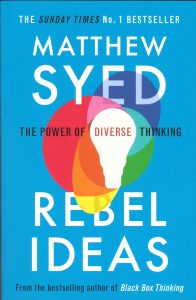The one sentence summary
Diverse thinking is far more powerful than when everyone agrees with each other.
Can’t be bothered to read it? Too much screen time lately? Listen to the 5-minute podcast.
WHAT THE BOOK SAYS 
- Collective blindness occurs when everyone thinks the same – a phenomenon often referred to as an echo chamber.
- Rebels think differently to clones, and constructive dissent leads to more intelligent innovation. A series of intelligent people can become unintelligent if they all think alike.
- A team of intelligent rebels fair well so long as they overlap a little, discuss things robustly, and pool perspectives that are germane and synergistic. They do not agree for the sake of it or parrot each other’s views. They challenge, augment, diverge and cross-pollinate. Diverse groups of problem solvers consistently outperform groups of the best and the brightest.
- With perspective blindness, we are oblivious to our own blind spots. We perceive and interpret the world through frames of reference, but we can’t see those frames.
- Homophily describes those who tend to associate and bond with others like themselves. This leads to a form of perpetual sameness in thinking and action – a form of homogeneity.
- In total, geniuses are less likely to experience innovation than networkers, because they don’t share ideas as much.
- When it comes to evolution, we tend to think that big brains lead to great ideas, but really it is the other way round – clever innovation has made our brains bigger. Our species is constructed on diversity – recombinations and discoveries that sweep through our networks, building the collective brain.
- When it comes to work environments, the lean condition is minimalist, but it doesn’t lead to good productivity. An enriched condition with plants and prints on the wall increases performance by 15%. Even better, in the personalised condition whereby people can design their own set up, they work 30% better than those in the lean condition.
- In the clone fallacy, we think in linear ways about complex, multi-dimensional challenges, and it doesn’t work well.
WHAT’S GOOD ABOUT IT
- In a typical 4-person group, 2 people do 62% of the talking. In a 6-person group, 3 people do 70% of the talking. Dominance and narrow thinking increase with the size of a group. This creates an uneven communication problem.
- If you come up with a new idea and share it with other people, its potential increases and multiplies. This is called information spillover.
- Focusing on averages can be misleading because, in a certain sense, the average is non-representative.
- “When an average is being used well, it’s harnessing the insights from multiple people. When it’s used badly, it’s imposing a solution for multiple people.” Neil Lawrence, Head of Machine Learning, Amazon
- A study into why some call centre workers performed better than others revealed that those using the web browsers Chrome and Firefox were better. Because these browsers are not pre-installed on computers, their presence demonstrates users who are more inquisitive. As a result they solve customer problems more creatively, for the better.
WHAT YOU HAVE TO WATCH
- Not much. There are powerful stories and examples here.
